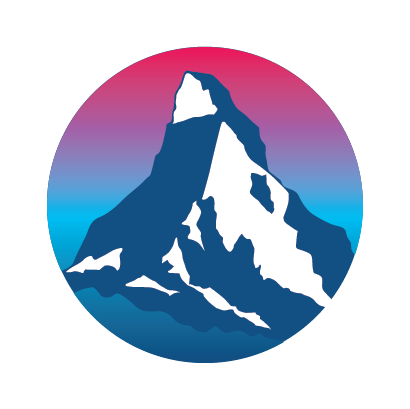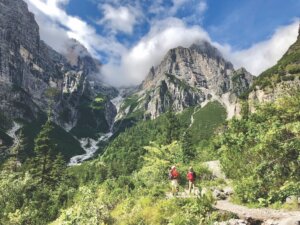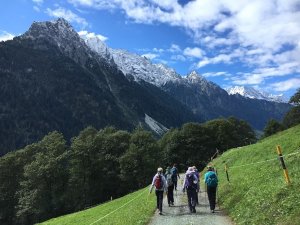
Ryder-Walker’s Seven Most Challenging Treks
Why not start training for one of Ryder-Walker’s more vigorous treks! Your efforts will be rewarded with an adventure of a lifetime. Follow the rugged cairn-marked trails across Iceland’s moonscape or climbing to the heights of the largest mountain passes in the Alps. There is something uniquely special about hiking hard to find yourself in the most remote and beautiful locations on earth. In this post, we will discuss Ryder-Walker’s seven most challenging treks, why they should be your new hiking goals, and how to prepare for them.
India, Nepal, and Bhutan – Hiking at the Top of the World
This summer Ryder Walker is offering a trifecta of Himalayan adventures, India: Markha Valley Trek, April 23 – May 4, Nepal: The Forbidden Kingdom of Mustang, May 8 – 25 and Bhutan: Thimpu, Linshi, Laya Trek, October 22 – November 6. All three of these treks share a few characteristics that make them epic adventures to put on your bucket list, including stunning views, high-altitude hikes, and itineraries that last over two weeks. They all skirt the flanks of the Himalaya, the highest mountains on earth. Much of the hiking is at a substantially higher altitude than our other treks.
The most important part of preparing for a trek through the Himalayas is taking time to adjust to the high altitude. In these areas, we often work extra days into the treks at lower altitudes in the local cities and villages, such as our hike to the Tiger’s Nest Temple in Paro at the start of our Bhutan trek. Here, we spend a day hiking a precipitous path to the Tiger’s Nest, one of the most famous Buddhist temples. Once completing the daring first hike, we take a moment in the temple to bless our journey into the Himalayas. This is traditionally done by local Sherpas and visiting alpinists.
Food, Altitude, and Culture
We recommend you schedule extra time in the cities at the start of these trips to get used to the food, altitude, and culture. Because our Himalayan trips are both demanding and far from home, they are also the longest trips we offer.
With multi-week hiking trips, you will feel your body becoming stronger as you progress through it. The reward for braving the heights of the Himalayas is unparalleled.
In Bhutan, you will get to visit the village of Laya, the remote home of the Laya people, a place only inhabited by a few hundred indigenous Layans and seen by even fewer tourists due to its remoteness! In Markha, India you will get to hike below the Siachen, the largest glacier outside of the polar circles. Exploring Nepal, we get to hike past Annapurna, a mountain steeped in climbing legend and lore! Another good way to prepare for this trek is to read Maurice Herzog’s Annapurna. Although we won’t be ascending Annapurna, it’s a fascinating read that talks of the trials of conquering the first of the Himalayan giants. Herzog’s ascent so impressed the world that he was named France’s Minister of Sport and the Mayor of Chamonix.

Norway and Iceland – Hiking off the Beaten Path
In the northern climes, Norway: The Islands of Lofoten, June 26 – July 3 and Iceland: The Remote Westfjords, July 7 – 14 and are both challenging in a particularly unique way and fall into Ryder-Walker’s seven most challenging treks. In these subarctic climates, the ground is often too pliable to support traditional trails. You will hike across boggy moss and sweeping rock outcroppings. The route follows trails marked by stone pillars or cairns, over ground that looks otherwise untraveled.
The reward for this style of hiking is that it truly feels as though you are traveling in places that humans have never traveled before. In Norway, the trails often lead you through the craggy fjords to secluded arctic beaches, where all sorts of interesting sea life frolic, such as puffins and walruses. In Iceland, you get to hike across the Hornstrandir, a peninsula that is only accessible by boat and will probably never have a road of any kind constructed either to or across it!
To prepare for this unique and challenging style of hiking, we recommend that you step outside of your comfort zone. As long as you don’t get lost, take a walk off the trail in the woods. Let yourself get used to covering uneven and varied terrain. You will find that it takes much more work to cover ground when you don’t have the assistance of a trail. If that’s not possible in your area, focus on your endurance at the gym. Building up the strength of your lungs and legs makes hiking across these Nordic moonscapes an approachable goal!

Eiger Trail and Matterhorn Trek – Huge Ascents and Descents in the Alps
The Eiger Trail, August 15 – 23 and the Matterhorn Trek, August 24 – 31 are the two most challenging hikes we offer in the Swiss and Italian Alps. Both treks borrow their names from the world-famous mountains we hike under. These treks are particularly demanding because of their long ascents. On either trip, you can expect to hike for up to seven hours a day with ascents up to 5,000 feet. These days are demanding but popular and the rewards are huge.
On our Eiger Trail, in the Swiss Alps we ascend to the Hohturli, the highest pass on the Via Alpina. On this hike you also pass by the Oeschinensee, one of the most beautiful alpine lakes in the world. Oeschinensee is just beneath the glaciated summit of the Blumlisalp. We even get to look down on the Blumlisalp itself. Blumlisalp is a glaciated field of ice that sits just outside of the hut at the pass, where we stop for a hard-earned lunch. On the Matterhorn Trek we hike over the Turlo Pass in the Italian Alps to the village of Macugnaga. Macugnaga sits directly beneath the staggering 10,000-foot relief of the east face of the Monte Rosa!
Preparation
To prepare for these adventures, we recommend that you focus on your stamina. Ryder-Walker’s seven most challenging treks do require training beforehand, so practice hiking uphill, whether outside or in the gym, and prepare yourself for the long ascents and descents. Getting ready to conquer these magnificent mountain passes should be your new fitness goal. You can achieve peak physical condition by running or hiking as regularly in the months before the trip.
























Comments are closed.